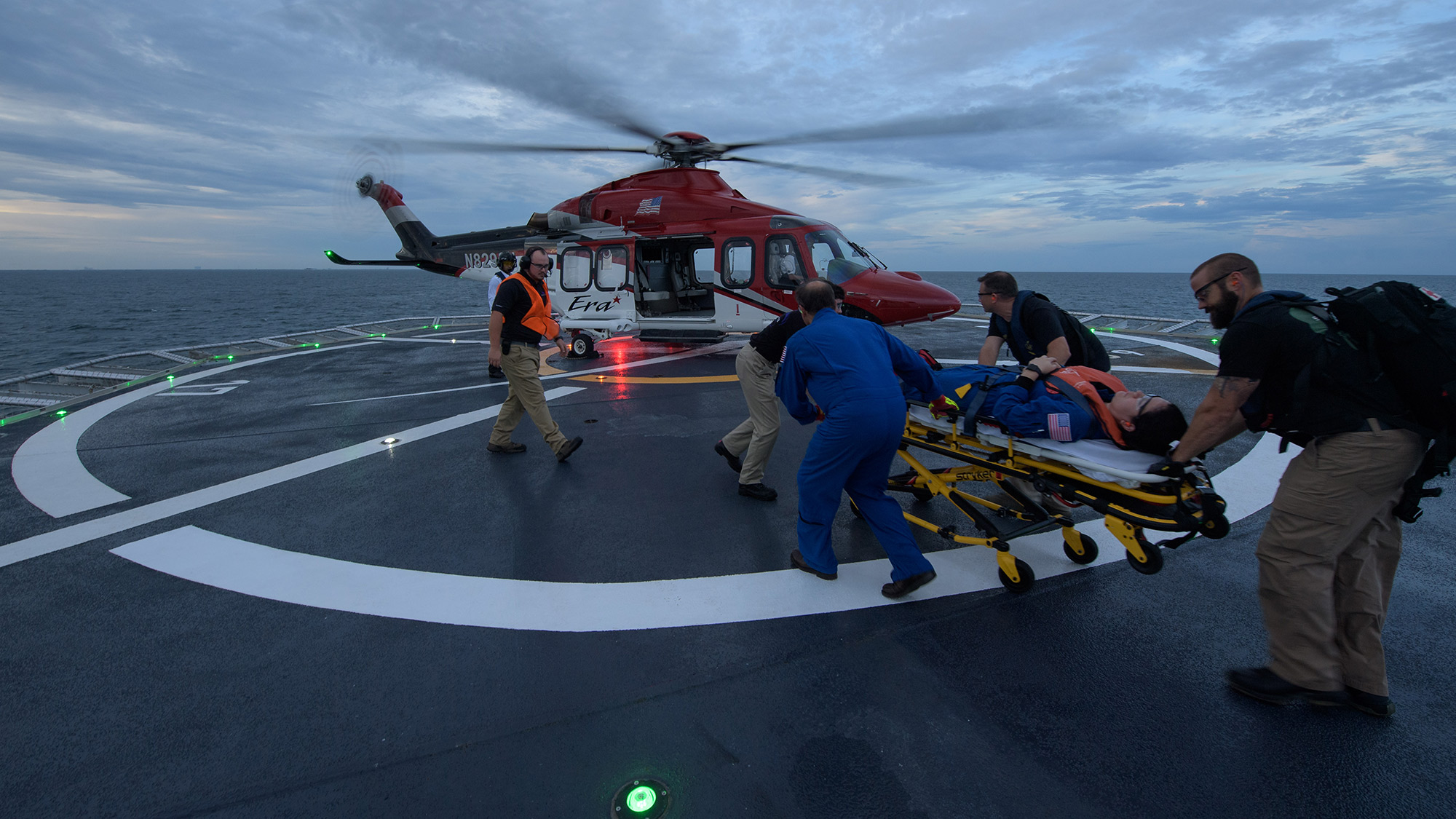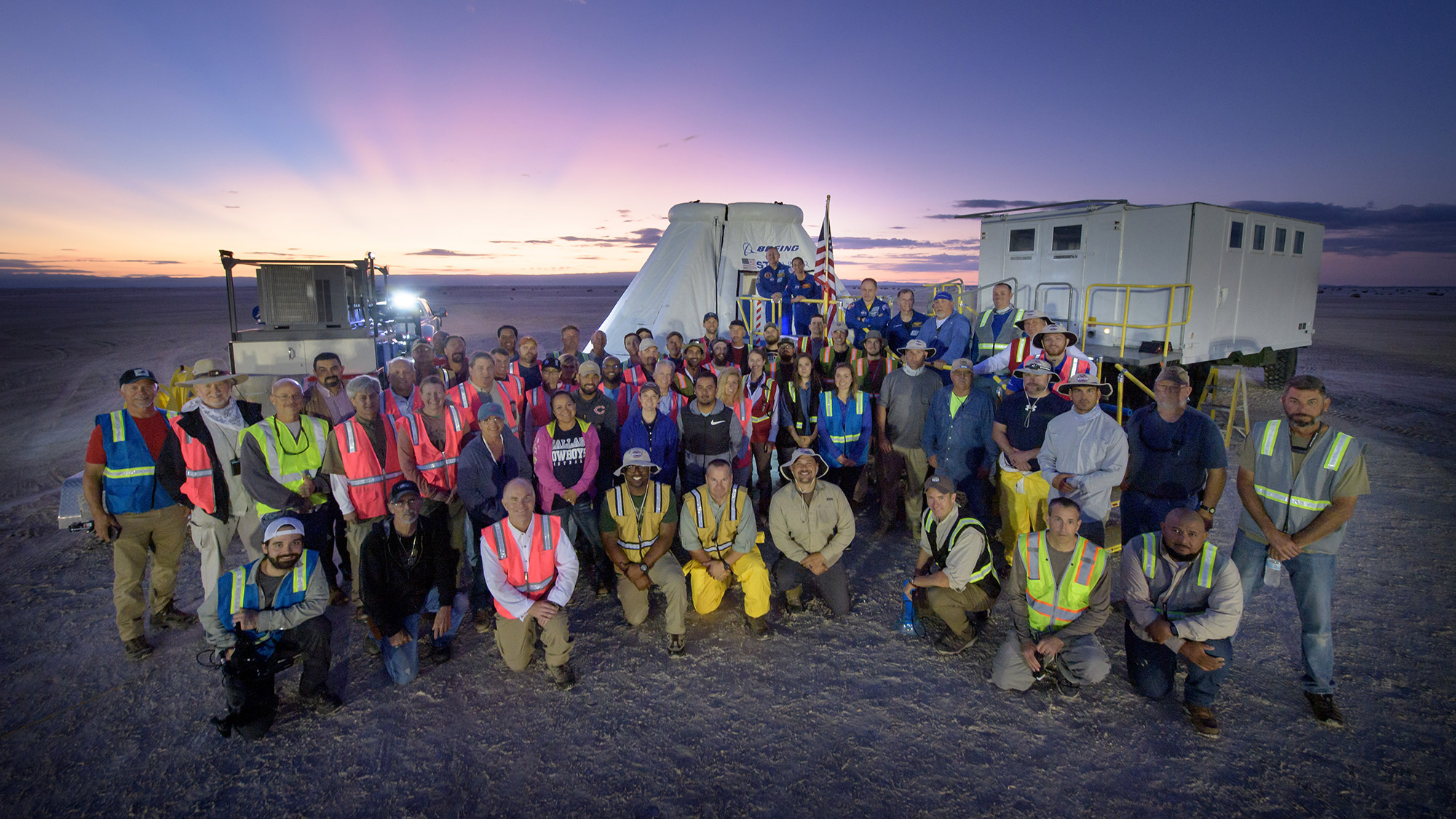In Photos: NASA Practices Emergency Astronaut Recovery with SpaceX, Boeing

In 2019, NASA practiced ways to extract astronauts from SpaceX's Crew Dragon and Boeing's Starliner space capsules. See photos of those very different emergency services here.
Up first was SpaceX's Crew Dragon spacecraft, a capsule designed to to launch astronauts into orbit on a Falcon 9 rocket and then return to Earth by splashing down in the Atlantic Ocean. A SpaceX ship, the Go Searcher, would then retrieve the capsule and its astronaut crew.
Here, NASA astronauts Doug Hurley (left) and Bob Behnken, who will fly aboard Demo-2 - the first crewed Crew Dragon mission to the International Space Station - prepare to practice the retrieval process with SpaceX on Aug. 13, 2019.

A main goal of the NASA-SpaceX astronaut retrieval session on Aug. 13 was to practice exactly how to recover astronauts in distress. How would recovery teams retrieve the astronauts safely and quickly, and then get them to dry land?
Here, the SpaceX recovery team on the Go Searcher ship retrieves astronaut Doug Hurley from the Crew Dragon (left) in a stretcher. Hurley is wearing his SpaceX spacesuit.

The SpaceX astronaut recovery rehearsal was performed at Trident Basin in Cape Canaveral in Florida. Teams from NASA and SpaceX practiced extracting astronauts from the Crew Dragon capsule, the mock-up of which can be seen in the background at right on the GO Searcher recovery ship.
The large, flat structure atop the ship (ringed by white railings) is a helicopter pad, which would fly astronauts to safety after recovery.

Here's a view of the helicopter pad atop SpaceX's Go Searcher recovery ship.
On Friday, Aug. 15, 2019. a storm briefly interrupted important astronaut recovery rehearsals, in which retrieval teams practiced medical emergency evacuation procedures to extract astronauts from a Crew Dragon vehicle.

Here's what an astronaut medevac might look like on a SpaceX mission.
Here on the helicopter pad of SpaceX's Go Searcher, teams from NASA and the company rehearse medical emergency evacuation protocols in the event of an astronaut medical issue during splashdown or recovery. The astronauts would be shuttled up to the helicopter from the Crew Dragon capsule secured below the pad on the Go Searcher ship.

NASA and SpaceX recovery teams teams spent two days in August practicing retrieval techniques for Crew Dragon astronauts.
This image, taken Aug. 15, 2019, shows the team after loading an astronaut stand-in aboard the helicopter for a fast trip to an onshore hospitals. The rehearsals aimed to practice and streamline medical emergency evacuation procedures by SpaceX and NASA ahead of the first crewed Crew Dragon missions, such as the Demo-2, which is set to launch in early 2020.

Here's the view from a helicopter as it rises away from SpaceX's Go Searcher recovery ship during the joint NASA-SpaceX medical emergency evacuation rehearsal. The Go Searcher can be clearly be seen out the window.

SpaceX was not the only company NASA practiced emergency astronaut recovery techniques with in 2019.
In September, NASA and Boeing performed a series of checks to practice retrieving astronauts from a mock-up of the CST-100 Starliner spacecraft, which NASA has contracted to fly astronauts to and from the International Space Station. Here are some photos from that Sept. 12 test, which occurred at the White Sands Missile Range in New Mexico.

It takes a lot of people to practice astronaut rescues. Here, the teams traveled by convoy into the White Sands Missile Range to practice landing and crew extraction from Boeing's CST-100 Starliner.
Unlike SpaceX's Crew Dragon vehicle, which is designed to splash down in the ocean, Boeing's Starliner is designed to land on solid ground. Instead of a recovery ship, NASA and Boeing will need a veritable fleet of trucks and other vehicles to recover astronauts.

NASA and Boeing used a convoy of vehicles and a boiler plate test model of the Starliner space capsule (center) to rehearse the necessary steps to safely retrieve crewmembers from the vehicle.
Boeing's Starliner is designed to use airbags to help cushion its landing on dry land.

This stretch is a familiar site for emergency recovery crews.
As with SpaceX's Crew Dragon, team members from NASA, Boeing and the White Sands Missile Range used it to practice recovering crewmembers from the CST-100 Starliner in the White Sands Missile Range.
The first Boeing Crew Flight Test mission in 2020 will be crewed by NASA astronauts Michael Fincke and Nicole Aunapu Mann along with Boeing astronaut Chris Ferguson.

Here's a closeup to the recovery hatch on Boeing's Starliner spacecraft.
Unlike Russia's Soyuz space capsules, which require astronauts and cosmonauts to exit from the top of the vehicle, Starliner has a side hatch for easier access.

From NASA: Part of the Starliner crew recovery rehearsal process at the White Sands Missile Range included working through steps necessary to safe the space capsule itself, allowing team members to prepare for future missions.

From NASA: "Through massive team effort, rehearsal for future CST-100 Starliner trips to the International Space Station — learning how to safe the capsule and aide crew members in exiting the vehicle — took place outside Las Cruces, New Mexico on the White Sands Missile Range."

Christine Lunsford joined the Space.com team in 2010 as a freelance producer and later became a contributing writer, covering astrophotography images, astronomy photos and amazing space galleries and more. During her more than 10 years with Space.com, oversaw the site's monthly skywatching updates and produced overnight features and stories on the latest space discoveries. She enjoys learning about subjects of all kinds.
